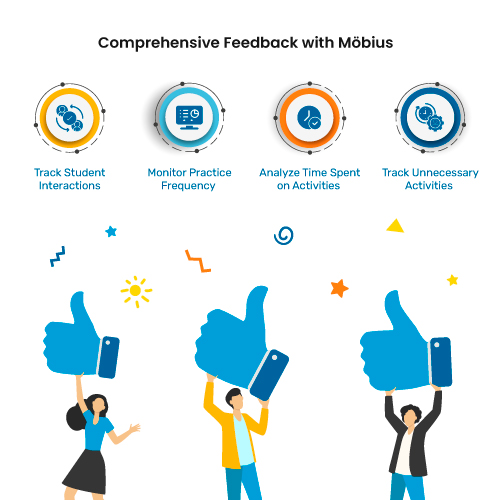Beyond Grades & Surveys: The Essential Role of Feedback for Teachers

Feedback plays a vital role in the realm of education. While we often stress the importance of providing feedback to students, it’s equally essential to consider feedback for teachers. This article examines why teacher feedback is crucial and why relying solely on student grades or surveys isn’t sufficient. Moreover, we’ll explore alternative approaches, such as utilizing data, to offer teachers valuable feedback.
When discussing quality education, the focus often neglects the methods employed by teachers. However, providing constructive feedback for teachers is immensely important. Such feedback aids in enhancing the engagement of their classes and contributes to better learning outcomes for students. Without valuable feedback, teachers may continue ineffective practices, which is detrimental to everyone involved.
The Limitations of Using Student Grades as Feedback
While student grades are commonly used to measure teaching effectiveness, they have limitations. For instance, imagine a scenario where a student scores well not solely due to the teacher’s efforts but because of external factors or personal abilities. Relying solely on grades may incorrectly attribute success to the teacher. Additionally, waiting until after final exams for teacher feedback misses opportunities for timely adjustments. Grades also fail to reflect the time and effort students invest in their studies. For example, a single mistake on a test question may represent hours of dedicated studying. Depending solely on grades overlooks areas needing extra support or alternative approaches.
The Limits of Relying on Student Surveys
Student surveys are often used to judge how well teachers are doing, but they have problems. One big issue is that each student has their own way of learning and preferences. Some students like things easy, while others want more challenging lessons. This means the good feedback for teachers from students might not be accurate for every educator.
Also, if a student likes their teacher, they might give them a good review, even if the teaching isn’t that great. On the other hand, if they don’t get along with their teacher, they might give them a bad review, even if the teaching is good. This makes it hard to know if the teacher is really doing a good job for everyone.
Another problem is that students might not always know what makes a good teaching pedagogy. They might prefer fewer assignments or more time for deadlines, even if that’s not the best for learning. Only relying on what students say in surveys without thinking about what actually works for teaching might lead to wrong decisions.
Furthermore, if only a few students do the survey, or if some groups of students don’t take part, the feedback for teachers won’t show what everyone thinks. Quiet students or those who don’t speak up might not get their say, which can make the feedback biased.
So, it’s important to remember that student surveys are just one part of understanding how well a teacher is doing. We must consider additional factors to gain a comprehensive understanding.
Utilizing Data Tools for Informed Feedback
To provide more effective feedback for teachers, we can utilize data tools. These tools monitor students’ learning processes, including the topics they study, their performance on practice exercises, and their achievements in various tasks. By analyzing this data, teachers can gain a deeper understanding of how students are interacting with the content and identify areas where they can enhance their teaching methods.
One notable tool is Möbius, a blended learning platform that transforms the feedback process for teachers. Möbius offers educators valuable insights into students’ interactions with lessons, assignments, quizzes, and video-based learning. This data enables teachers to comprehend students’ preferences, obstacles, and learning preferences more thoroughly.
With the interactive Möbius blended learning platform, educators can:

- Track Student Interactions with Activities: Möbius shows how students engage with each activity, such as participating in discussions, completing assignments, or taking quizzes. This feedback facilitates teacher feedback by revealing what methods are working best and which activities students enjoy the most.
- Monitor Practice Question Frequency: Practice is crucial for learning, particularly in subjects like problem-solving. Möbius allows teachers to monitor how often students practice questions related to specific topics, aiding in understanding students’ reinforcement and practice levels.
- Analyze Time Spent on Activities and Questions: Educators using Möbius can analyze the time students spend on various activities and questions, indicating the difficulty or complexity level. This enables educators to identify challenging concepts and comprehend students’ interests and strengths, contributing to good feedback for teachers.
- Identify Time Spent on Unnecessary Activities: Möbius highlights instances where students might be allocating too much time to less critical activities. This feature empowers teachers to streamline the curriculum and focus on more impactful learning tasks.
By leveraging data tools like Möbius, teachers can acquire valuable insights into student learning behaviors and adjust their teaching methods to better align with students’ needs and preferences, fostering effective teacher feedback.
Data-Informed Decisions for Enhanced Engagement & Learning Outcomes
The Möbius blended learning platform offers comprehensive feedback and multifaceted student assessment, enabling educators to pinpoint patterns, trends, and areas necessitating support or adjustments in teaching methods. Möbius serves as a valuable ally for teachers. It monitors students’ progress in class, including their preferences for activities, performance on assignments, and comprehension of lessons.
Consider a math teacher who incorporates engaging activities and visuals into their lessons. With Möbius, they can assess whether these methods effectively facilitate student learning, providing valuable feedback for teachers.
For example, Möbius might show that when the teacher uses numerous interactive activities, students get more excited and understand math concepts better. So, the teacher decides to use even more of these fun activities to further enhance math learning.
In short, Möbius helps teachers make smarter decisions based on real data regarding the most effective approaches for students. By using Möbius and paying attention to such feedback, teachers can establish classrooms where every student can succeed.
Conclusion
Feedback for teachers is like a superpower, helping them grow and improve their teaching skills while making a positive impact on how students learn. By recognizing the importance of teacher feedback and going beyond old-fashioned ways of measuring success, we give teachers the tools they need to become even better at what they do.
Depending only on student grades or surveys isn’t enough to understand how well teachers are doing. That’s where Möbius comes in. By using Möbius and looking at feedback from all angles, we can create classrooms where learning never stops, students are excited to participate, and everyone has the chance to shine and succeed.
Want to explore the Möbius experience? Book a personalized demo!
Author
Deepali Singh